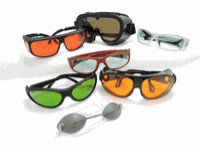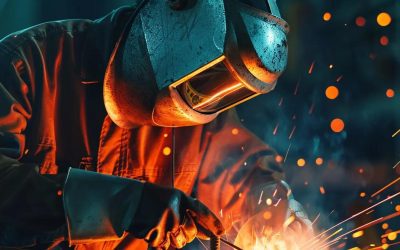How to Choose the Best Laser Safety Glasses & Goggles
Check out the video above for a quick description of how to select laser safety goggles.
Here is a quick overview of the considerations when choosing laser safety glasses or laser safety goggles to wear in the workplace. Both may be referred to as LSGs, but we will use laser safety glasses for the rest of this article.
Can Lasers Damage My eyes?
Absolutely, lasers can damage your eyes. All laser radiation can be harmful to your eyes. Laser energy is concentrated and therefore hundreds of times more powerful than the light from a standard light bulb. Although they are considered safe, even common laser pointers can cause permanent damage if used irresponsibly.
The majority of lasers require the use of eye protection, such as laser safety goggles, when being used.
Lasers can be classified by their hazard level. The hazard level is determined by the laser’s capability of inducing damage onto any personnel, operators, or viewers.
Lasers with higher classifications, such as Class 3B and Class 4, have higher levels of risk.
Here are the classifications of lasers:
- Class 1 and Class 1M: Not capable of damaging the human body or eyes.
- Class 2 and Class 2M: Safe unless viewed directly for long periods of time.
- Class 3R: Can be momentarily hazardous when directly viewed or when staring directly at the beam with an unaided eye.
- Class 3B: Immediate skin hazard from direct beam and immediate eye hazard when viewed directly.
- Class 4: Immediate skin hazard and eye hazard from exposure to either the direct or reflected beam; may also present a fire hazard.1
Lasers that have beams that operate outside of the visible spectrum, such as infrared and UV lasers, are particularly dangerous because they can harm your eyes with no indication that you have been injured until it’s too late.
How Do Laser Safety Glasses Protect My Eye?
Laser safety glasses use a process called attenuation, which limits the amount of energy passing through the lens. Safety glasses can be made of glass or plastic.
Glass lenses contain rare elements that absorb the energy, thus preventing the energy from reaching your eyes. Plastic lenses have inorganic dyes that block the passing of certain wavelengths.
Plastic lenses block specific wavelengths, which is why it’s important to know which wavelengths you want to protect yourself from. Since plastic lenses contain dyes, they tend to be darker than glass lenses for the same wavelength ranges.
It is important to consider the differences between glass and plastic lenses before choosing laser glasses in your wavelength range.
Attenuation begins with the laser itself. What is the laser’s wavelength? This affects the Optical Density (OD). Wavelength ranges go from Ultraviolet (100-400 nm) to Visible (440-750nm) to Infrared (750nm to 1mm). Visible light also varies in color and LSGs have specs to cover these factors.
The Maximum Permissible Exposure (MPE) measures the degree to which the cornea (the transparent layer in the front of the eye) is safely exposed to a laser beam. OSHA measures MPE on wavelength, pulse duration, amount of cornea exposure time to the beam, and the size of the image hitting the retina.
Lasers are also measured in terms of their pulse mode – constant, single or repetitive.
Laser Safety Glasses achieve attenuation through (1) light filtration with colored lenses or clear lenses with special coatings; (2) allowing enough light to do the job without allowing harmful light in; and (3) blocking unsafe wavelengths with lens chemicals and dyes.
Should I Always Wear Laser Safety Glasses?
The best way to protect yourself is to always follow the rules for using your laser. It’s important to follow a standard operating procedure written by a Laser Safety Officer (or LSO) which details the necessary safety precautions while operating machinery. If you do not have a Standard Operating Procedure (or SOP) for this, follow the rules in the manual that is provided with the laser.
Always wear the proper safety glasses for the specified laser range which you are working with. Do not seize safety interlocks or beam control devices. In addition, do not use the laser for other than it was intended. Always refer to the SOP or safety manual if you are unsure of proper procedure or usage. As previously stated, NEVER look directly into the path of the laser.
Lastly and most importantly: Use common sense! If you think something might pose a safety risk, then don’t do it.
What Kind Of Laser Safety Glasses Do I Need?
There are several things to consider when choosing laser safety glasses. First, you need to know which wavelength range you need for your line of work. From there you can select glasses within that range. There is a vast amount of laser ranges, so it’s important to select the proper range to ensure that your glasses will fully block any intercepting wavelengths.
The last consideration is the Visible Light Transmission (or VLT) of the lens. This is the amount of visible light that is passed through the lens while still protecting you from the specified wavelength. After meeting the first two considerations, you should pick the lenses with the highest VLT available. We suggest choosing the VLT last so that you can ensure the highest possible amount of protection from wavelengths.
Your Laser Safety Officer is responsible for determining what type of personal protective equipment is needed for your workplace. If you work with or around Class 3b or 4 lasers, your LSO should provide you with laser safety training.
OSHA Mandates for Class 3 and Class 4 Lasers
OSHA mandates proper Laser Safety Glasses (LSGs) when using Class 3B or 4 lasers. [1] In some cases, it is also recommended for Class 3A lasers. Laser Safety Officers determine the best LSGs and for training employees in their proper use and maintenance.
Here’s a quick snapshot of Class 3 and Class 4 lasers [2] & [4] before we look at the A-B-C’s of eye protection as part of a laser safety program.
Class 3: There are two subclasses of Class 3 lasers.
Class 3A lasers are not usually dangerous unless used in optical instruments such as microscopes. Suggested labeling: “Caution – Avoid Direct Eye Exposure.”
Class 3B lasers have a higher potential for eye injuries. OSHA regulation 1926.102(a)(2) requires the use of LSGs when using Class 3B lasers. Suggested labeling: “Warning – Avoid Direct Exposure to Beam.”
Class 4: These lasers are powerful and can cause both eye and skin injuries. Due to this danger, OSHA requires proper laser safety glasses when using Class 4 lasers.
The Importance Of A Laser Safety Program
A laser safety program starts with proper training and consistent monitoring of employee compliance with their training. Requiring the use of LSG’s doesn’t always mean employees will be compliant. Why would employees ignore rules and put themselves at risk for injury or permanent vision loss? The wrong LSGs can be ugly, uncomfortable, and even unsafe. Having a “one size fits all” LSG policy can lead to hit-or-miss compliance.
The bottom line is that there is no definitive guide to purchasing the correct LSGs. That said, there are some common pitfalls to avoid when choosing proper LSGs:
- Fit – LSGs should be adjustable and not slip down or become too loose. If they don’t fit right, they’re less likely to be worn.
- Comfort – LSGs should be comfortable to avoid distractions and complaints. They need to be sturdy but lightweight and have rubber nose pads.
- Prescription – LSGs should offer a prescription option; note that not all do.
- Composition – LSGs can come with polycarbonate or glass filters. Each has advantages.
- Specific – LSGs must be specific to the laser environment and meet or exceed ANSI Z136.1 requirements. [4]
- Maintenance – LSGs must be properly maintained. This includes cleaning them daily with a soft, microfiber cloth and a mild soap with water. LSGs should be stored in a protective hard case.
Maintenance also means replacing LSGs when needed. The Laser Safety Officer (LSO) should have periodic, scheduled checks of LSGs for needed replacement.
Laser accidents are bad for employee morale and bad for business. Establishing a safe laser workplace begins with having the correct LSGs.
Ensuring a safe laser environment begins with training. Annual training should be a part of every laser safety program, regardless of the education and experience level of the employees.
Laser Safety Eyewear Vendors
Laser Safety Certification, LLC does not endorse or receive compensation from any of these vendors. We are providing their links here as a reference because they are trusted vendors in our experience.
Cascade Laser Corp.: https://www.cascadelaser.com/laser-safety-eyewear.html
Phillips Safety Products: https://www.phillips-safety.com/product-category/laser-safety/laser-safety-glasses
Thor Labs: https://www.thorlabs.com/newgrouppage9.cfm?objectgroup_id=762
Laservision USA: https://lasersafety.com/
Laser Safety Industries: https://lasersafetyindustries.com/collections/eyewear
How can Laser Safety Certification help?
At Laser Safety Certification, we have laser safety certification courses and Laser Safety Officer certification programs to make sure your team is correctly using lasers and your customers are protected. LSGs and other Personal Protective Equipment (PPE) are just one part of a complete laser safety program.
We have laser safety certification courses for Industrial, Laboratory, Cosmetic, Medical/Healthcare, and Veterinary laser users. We also have Laser Safety Officer certification courses to help organize your company’s laser safety program. We base this training on the current OSHA Technical Manual sections applicable to laser hazards. We can also provide laser safety kits and bundles to help your LSO administer your laser safety program to protect your team as well as your customers.
We have on-line and easy to use laser safety training for technicians and operators based on OSHA recommendations and ANSI guidelines. Our OSHA compliant LSO certification courses can help you become a Laser Safety Officer to administer a laser safety program for your entire team.
Click here to enroll your company to get started today. Or check out our FAQ section with common answers about our courses, certification options, and kit offerings. You can send us an email at info@lasersafetycertification.com if you want more information on how we can help your business use lasers safely while protecting your employees and your customers.
References
[1] OSHA PPE/LSG Standards (29 CFR 1910): https://www.osha.gov/laser-hazards/standards
[2] NoIR Laser standard summary: http://noirlaser.com/laser-standards
[3] Laser Safety Facts Laser safety classes overview: https://www.lasersafetyfacts.com/classes-menu.html
[4] Laser Institute of America ANSI Z.136: https://www.lia.org/resources/laser-safety-information/laser-safety-standards/ansi-z136-standards
Image Credit: Cascade Laser Corp




